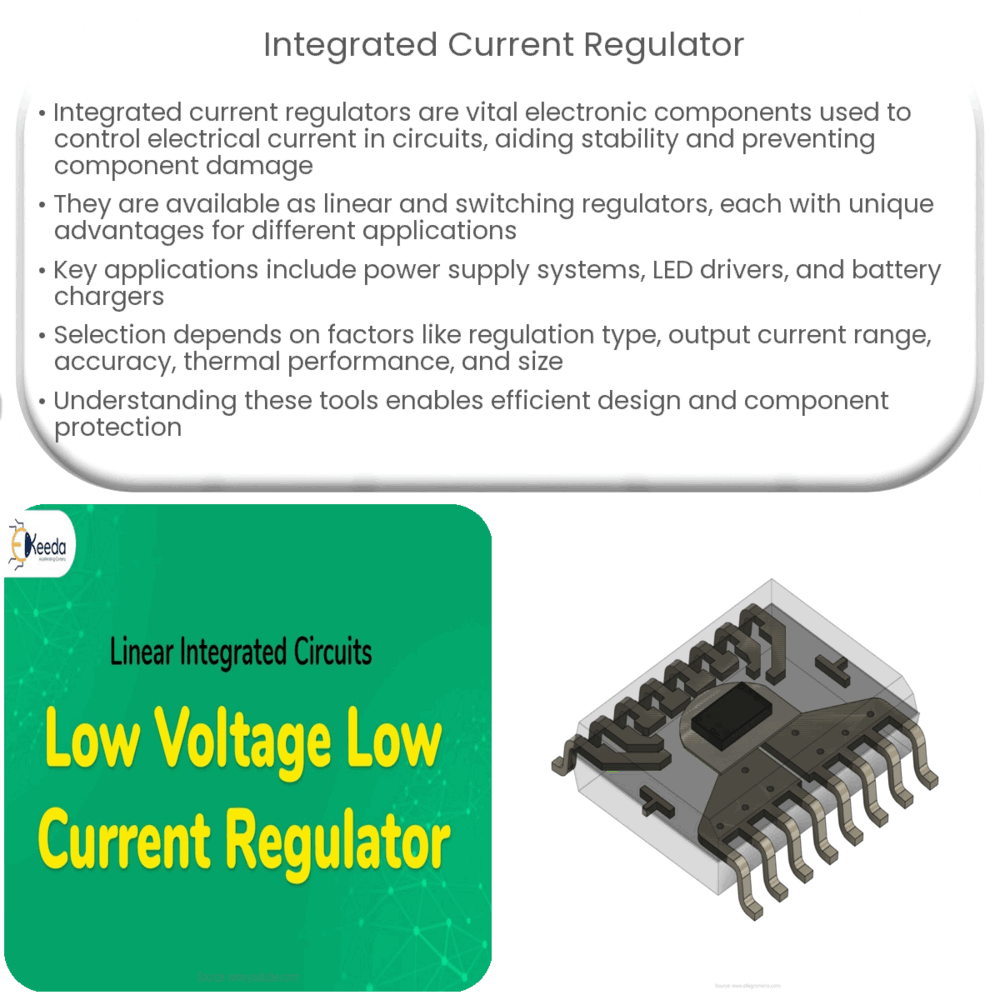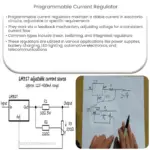An integrated current regulator is a vital electronic component that controls current flow, ensuring circuit stability and preventing component damage.

Introduction to Integrated Current Regulators
Integrated current regulators are essential electronic components in a variety of applications, from power supply systems to sophisticated signal processing circuits. These components are designed to control the flow of electrical current in a circuit, ensuring stability and preventing damage to other components. In this article, we will explore the fundamentals of integrated current regulators, their common types, and their practical applications in modern electronics.
Why Do We Need Integrated Current Regulators?
Electrical circuits are designed to operate within specific current and voltage ranges to ensure optimal performance and prevent damage to their components. However, fluctuations in input voltage or load conditions can cause variations in the current flowing through the circuit. These fluctuations may lead to overheating, component failure, or even catastrophic damage to the entire system. Integrated current regulators provide a solution to these issues by controlling the flow of electrical current and maintaining it within the desired range.
Types of Integrated Current Regulators
There are two primary types of integrated current regulators: linear and switching. Each type offers unique advantages and is suited for different applications.
Linear Current Regulators
Linear current regulators, also known as series regulators, work by adjusting the resistance in the current path to regulate the output current. They are typically composed of a voltage reference, an error amplifier, and a pass element (usually a transistor). The voltage reference provides a stable reference voltage, and the error amplifier compares this reference voltage to a portion of the output current. The pass element is then adjusted accordingly to maintain the desired current level.
Linear current regulators are simple to implement and provide a low-noise output, making them ideal for sensitive analog circuits. However, they can be less efficient compared to switching regulators, as the excess energy is dissipated as heat.
Switching Current Regulators
Switching current regulators control the output current by rapidly turning a switch (usually a transistor) on and off. The average current flowing through the circuit is determined by the duty cycle of the switch. Switching regulators are more efficient than linear regulators, as they do not dissipate the excess energy as heat. Instead, they convert it into useful output power.
Switching regulators are commonly used in power supply systems, where efficiency is crucial. However, they can generate more electrical noise than linear regulators, making them less suitable for sensitive analog circuits.
Applications of Integrated Current Regulators
Integrated current regulators can be found in a wide range of electronic devices, serving various purposes. Some common applications include:
- Power supply systems: Current regulators are critical in maintaining stable output voltages and preventing damage to components in power supply systems.
- LED drivers: LEDs require precise current control for optimal performance and long lifespan. Integrated current regulators provide the necessary control, ensuring stable and efficient operation.
- Battery chargers: To safely and efficiently charge batteries, a controlled current must be applied. Integrated current regulators enable this precise control, ensuring optimal charging performance.
Current Regulation Techniques
Depending on the specific application and requirements, different current regulation techniques can be employed using integrated current regulators. These techniques include:
- Constant current regulation: In this method, the regulator maintains a constant output current irrespective of the input voltage or load variations. This technique is widely used in LED drivers and battery chargers.
- Current limiting: Current limiting is a technique used to protect components from excessive current flow. The regulator restricts the output current to a predefined limit, preventing damage to the circuit components in case of short circuits or overloads.
- Current foldback: This technique combines constant current regulation with current limiting. When the output current exceeds a predefined limit, the regulator reduces the output current to protect the circuit components. This method is commonly used in power supplies to protect against short circuits and overloads.
Selecting the Right Integrated Current Regulator
When choosing an integrated current regulator for a specific application, several factors should be considered:
- Regulation type: Determine whether a linear or switching regulator is best suited for your application, based on factors such as efficiency, noise sensitivity, and complexity.
- Output current range: Choose a regulator that can handle the desired output current range for your application.
- Accuracy: Consider the level of current regulation accuracy required for your application. Higher accuracy usually comes at a higher cost and may require additional components for fine-tuning.
- Thermal performance: Ensure that the regulator can handle the heat generated during operation, especially in high-current or high-temperature applications. Adequate heat dissipation may require the use of heat sinks or other cooling methods.
- Size and packaging: Select a regulator with an appropriate package size and form factor to fit within the constraints of your design.
Conclusion
Integrated current regulators play a crucial role in maintaining the stability and performance of electronic circuits. By understanding their types, operation principles, and applications, engineers can effectively select and implement the appropriate current regulator for their specific needs. This ensures optimal performance, improved efficiency, and protection for critical circuit components.
As electronic devices continue to evolve, integrated current regulators will remain a vital component in the design and development of advanced circuits. By staying informed on the latest advancements in current regulation technologies, engineers can continue to push the boundaries of what is possible in modern electronics.



